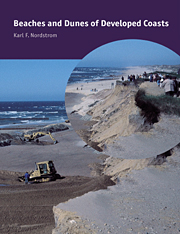Book contents
- Frontmatter
- Contents
- Preface
- Acknowledgements
- 1 The developed coastal landscape: temporal and spatial characteristics
- 2 Altering landforms to suit human needs
- 3 Replenishing landforms
- 4 Effects of structures on landforms and sediment availability
- 5 Characteristics of human-altered coastal landforms
- 6 Temporal scales of landscape change
- 7 Management programs
- 8 Maintaining and enhancing natural features in developed landscapes
- 9 Directions for geomorphological research
- References
- Index
4 - Effects of structures on landforms and sediment availability
Published online by Cambridge University Press: 18 December 2009
- Frontmatter
- Contents
- Preface
- Acknowledgements
- 1 The developed coastal landscape: temporal and spatial characteristics
- 2 Altering landforms to suit human needs
- 3 Replenishing landforms
- 4 Effects of structures on landforms and sediment availability
- 5 Characteristics of human-altered coastal landforms
- 6 Temporal scales of landscape change
- 7 Management programs
- 8 Maintaining and enhancing natural features in developed landscapes
- 9 Directions for geomorphological research
- References
- Index
Summary
Introduction
This chapter identifies the direct effects of human structures on geomorphic processes and the resulting effects on coastal sediment budgets and landforms. The structures that are discussed are designed for shore protection, navigation, recreational boating, beach recreation, housing and transportation. Artificial islands and structures outside the coastal zone that affect sediment budgets are also addressed. The effects of modifying beaches and dunes to build these structures and the effects of human actions in redistributing sediment to use these structures or mitigate their effects were discussed in chapters 2 and 3. The characteristics of landforms associated with many of these structures are addressed in chapter 5.
Protection structures
The body of literature on shore protection structures is enormous, and the functions of the many types of these structures are well known (Silvester and Hsu 1993). Impetus for conducting most geomorphic studies of these structures is provided by the need to address the initial erosion problem, invariably related to local deficiency in the sediment budget. Frequently, the effect of these structures is to displace the locus of erosion to adjacent unprotected areas, resulting in a need to address subsequent erosion problems in those areas. These kinds of geomorphological investigations are most often couched in an applied investigative mode, examining the suitability of alternative means of protection.
There is ample evidence of accelerated erosion rates, pronounced breaks in shoreline orientation and truncation of the beach profile downdrift of shore perpendicular structures (Figure 4.1) (Everts 1979; Leatherman 1984; Nersesian et al. 1992) and reduced beach widths (relative to unprotected segments) where shore-parallel structures have been employed over long periods of time (Hall and Pilkey 1991).
- Type
- Chapter
- Information
- Beaches and Dunes of Developed Coasts , pp. 98 - 139Publisher: Cambridge University PressPrint publication year: 2000



